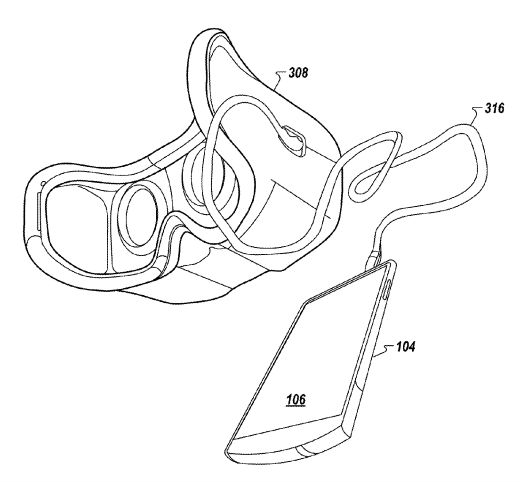A patent filed by Google in February and published Sept. 15 shows a VR headset that might be powered by a phone you hold in your hand. The connection between the headset and phone would run over a long thin cord to a lightweight headset, or it could one day be completely wireless.
There’s potential in the configuration to decrease the weight of a VR headset — making it seem more invisible — while turning the phone into a hand-held touch- and motion-sensing controller. The headset would presumably have its own display, but the phone could receive tracking information from the headset and do the processing necessary to draw a virtual world. Inventors listed appear to be members of the Google VR team, including Andrew Nartker, Clayton Woodward Bavor, JR. (Clay Bavor?), Alexander James Faaborg, Glen Murphy, Andrey Doronichev, Christian Plagemann, Shiqi Chen, Jon Michael Wiley, Manuel Christian Clement, Murphy Stein, and Samuel Mark Matson.
Patents are frequently filed to cover a variety of approaches to a particular technology, many of which never actually get used. This kind of implementation for a VR headset isn’t entirely new, but if done well it might offer a number of advantages. Most VR headsets available today use existing hardware for part of the experience (PlayStation 4, Samsung Galaxy smartphones, or PCs) that make it easier for people to adopt VR since millions of people already own some of the equipment needed. If you own a Galaxy S6 and its true cost is around $600, getting a VR experience is only ~$100 more then for a Gear VR and/or a bluetooth gamepad.
If you own a $1,000 gaming PC, getting a Rift or Vive with hand controllers is probably going to be around $800. So if the rough range for a full VR system today is $700 to $1,800, there might be a market for a lower cost but higher quality specialized VR device. Such a system might bring your hands into VR or offer wireless freedom without the battery-draining cellular connectivity of a phone or the excess size of a full-tower PC. This is where a patent like this by Google might come into play.
Google is currently preparing to release Daydream, which is a push toward high-end Android phones that pair with a headset we expect to be able to provide an experience that is better than Cardboard with the addition of a basic wireless motion-sensing controller to the mix. Daydream-compatible phones are expected to be completely wireless and slot into the headset as the VR display, the same as Gear VR and Cardboard. Google competitor, the Facebook-owned Oculus, is expected to detail its latest developments at a conference in San Jose from Oct. 5-7.



























